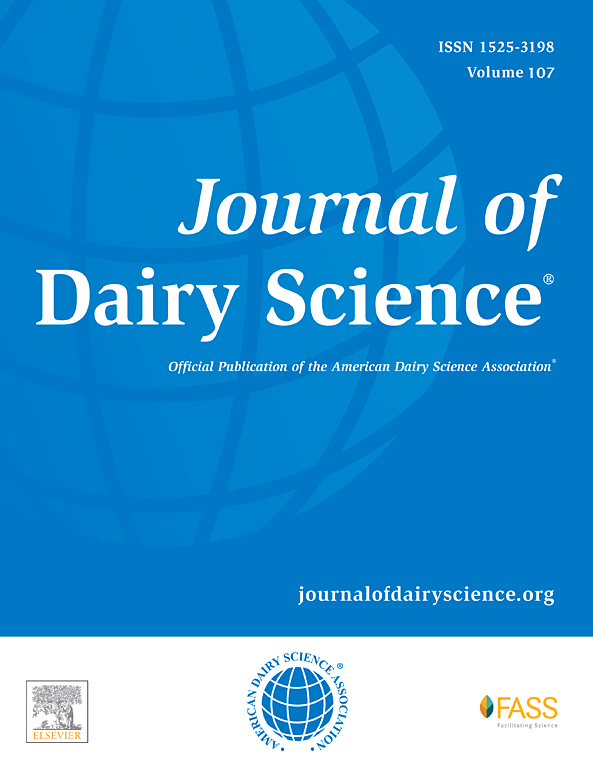瓦隆荷斯坦奶牛中红外预测产甲烷遗传参数及其与生产性状的关系
摘要
通过基因选择减少奶牛的甲烷产量可能是减少乳制品生产对气候变化影响的有效途径。在这项研究中,研究了与2个常用的每日甲烷特征(预测每日甲烷排放量[PME; g/d])和对数转换预测甲烷强度(LMI = log [PME/产奶量(kg)])相关的遗传参数和基因组区域。PME (g/d)数据使用常规记录的牛奶中红外光谱进行预测,这些数据收集于2007年至2023年间,分布在比利时瓦隆地区1520个畜群中的285,530头荷斯坦奶牛(1,920,130个测试日记录),224,643头荷斯坦奶牛(1,516,843个测试日记录)和160,226头荷斯坦奶牛(1,072,725个测试日记录)。该研究使用了7375只动物(1798头公牛)的565,049个snp数据,这些snp位于29个牛常染色体(BTA)上。采用随机回归试验日模型,通过贝叶斯吉布斯抽样法估计遗传参数。通过单步基因组BLUP方法估计SNP解决方案。计算由50个连续snp(平均大小为~ 212 kb)的窗口解释的遗传变异比例,并使用至少占总加性遗传变异1.0%的区域来搜索位置候选基因。泌乳第1期、第2期和第3期奶牛平均日PME分别为324.3 (66.88)g/d、355.0 (68.75)g/d和367.1 (71.42)g/d,平均日LMI分别为2.64(0.36)、2.61(0.39)和2.58(0.40)。在第一、第二和第三泌乳时,PME的平均(SD) h2分别为0.22(0.05)、0.20(0.05)和0.21 (0.05),LMI的平均(SD) h2分别为0.25(0.05)、0.23(0.05)和0.22(0.05)。在第一、第二和第三哺乳期,PME和LMI之间的平均遗传相关(SD)分别为0.53(0.04)、0.46(0.12)和0.43(0.16)。产奶量(MY)、脂肪率(FP)、蛋白质率(PP)、乳尿素浓度(MU)和SCS的遗传相关分别为-0.12 (MY) ~ 0.42 (FP)、-0.09 (MY) ~ 0.47 (FP)和-0.07 (MY) ~ 0.43 (FP)。对于LMI,估计的遗传相关性分别为-0.89 (MY)至0.56 (FP), -0.91 (MY)至0.55 (FP)和-0.90 (MY)至0.50 (FP)。全基因组关联分析鉴定出4个基因组区域(BAT1 144.38 ~ 144.47 Mb和BAT14 1.52 ~ 2.15 Mb、BAT14 2.19 ~ 2.57 Mb和BAT14 2.67 ~ 2.98 Mb)包含与甲烷特征相关的SLC37A1 (BTA1)、AHARPIN、MROH1、DGAT1、FAM83H、TIGD5、MROH6、NAPRT、GML、LYPD2和JPK (BTA14)。本研究结果有助于揭示甲烷排放的基因组背景,并可用于未来实施瓦隆荷斯坦奶牛甲烷排放的基因组评估。Genetic selection to reduce methane production from dairy cows may be an efficient way for reducing the impact of dairy production on climate change. In this study genetic parameters and genomic regions associated with 2 commonly used daily methane features (predicted daily methane emission [PME; g/d]), and log-transformed predicted methane intensity (LMI = log [PME/milk yield (kg)]) were investigated. The PME (g/d) data, predicted using routinely recorded milk mid-infrared spectra, collected between 2007 and 2023 on 285,530 first-parity (1,920,130 test-day records), 224,643 second-parity (1,516,843 test-day records), and 160,226 third-parity (1,072,725 test-day records) Holstein cows distributed in 1,520 herds in the Walloon region of Belgium were used. Data of 565,049 SNPs, located on 29 Bos taurus autosomes (BTA), on 7,375 animals (1,798 bulls) were used. Random regression test-day models were used to estimate genetic parameters through the Bayesian Gibbs sampling method. The SNP solutions were estimated through a single-step genomic BLUP approach. The proportion of genetic variance explained by windows of 50 consecutive SNPs (with an average size of ∼212 kb) was calculated, and regions accounting for at least 1.0% of the total additive genetic variance were used to search for positional candidate genes. Mean (SD) daily PME per cow was 324.3 (66.88) g/d, 355.0 (68.75) g/d, and 367.1 (71.42) g/d, while the mean daily LMI was 2.64 (0.36), 2.61 (0.39), and 2.58 (0.40) for the first, second, and third lactation, respectively. Mean (SD) h2 estimates for PME were 0.22 (0.05), 0.20 (0.05), and 0.21 (0.05) and for LMI were 0.25 (0.05), 0.23 (0.05), and 0.22 (0.05) in the first, second and third lactation, respectively. Average genetic correlations (SD) estimated between PME and LMI were 0.53 (0.04), 0.46 (0.12), and 0.43 (0.16) in the first, second, and third lactation, respectively. The genetic correlations estimated between PME and production traits, including milk yield (MY), fat percentage (FP), protein percentage (PP), milk urea concentration (MU), and SCS, ranged from -0.12 (MY) to 0.42 (FP), -0.09 (MY) to 0.47 (FP), and -0.07 (MY) to 0.43 (FP) for the first, second, and third lactations, respectively. For LMI, the estimated genetic correlations ranged from -0.89 (MY) to 0.56 (FP), -0.91 (MY) to 0.55 (FP), and -0.90 (MY) to 0.50 (FP) for the first, second, and third lactations, respectively. Genome-wide association analyses identified 4 genomic regions (BAT1 144.38-144.47 Mb and BAT14 1.52-2.15 Mb, BAT14 2.19-2.57 Mb and BAT14 2.67 - 2.98 Mb) harboring genes including the SLC37A1 (BTA1), AHARPIN, MROH1, DGAT1, FAM83H, TIGD5, MROH6, NAPRT, GML, LYPD2, and JPK (BTA14) that were associated with the studied methane features. The findings of this study help to unravel the genomic background of methane emissions and can be used for the future implementation of genomic evaluation of methane emissions in Walloon Holstein cows.

 求助内容:
求助内容: 应助结果提醒方式:
应助结果提醒方式:


